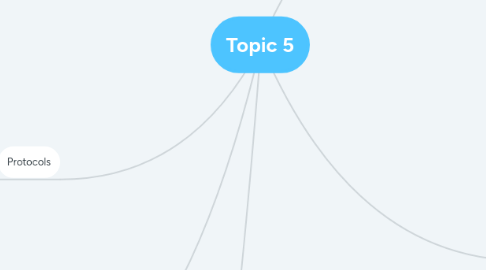
1. A computer network is when you connect devices to share data/resources.
1.1. Advanatges
1.1.1. It saves time when you share data with multiple people
1.1.2. The data is easy to backup
1.1.3. Devices can be shared using a network
1.2. Disadvantages
1.2.1. Viruses can spread to computers through a network
1.2.2. If the server crashes the files are inaccessible
1.2.3. Networks can slow down when too many people are using it
2. Packets
2.1. Header
2.1.1. The header contains addressing and other data that is required to reach it's desired destination
2.2. Body
2.2.1. Contains the actual information/data being sent
2.3. Footer
2.3.1. Contains a few bits that tell the receiving device that the packet has ended, the bits also sometimes check for errors
3. Network topologies
3.1. Bus
3.1.1. Advantages
3.1.1.1. It's quite cheap to set up as less cables are needed
3.1.1.2. Easy to add computers to the network without disconnecting computers
3.1.2. Disadvantages
3.1.2.1. The performance of the network will slow down if more than 10 computers are connected
3.1.2.2. If the main cable fails then the whole network will turn off
3.2. Ring
3.2.1. Advanatges
3.2.1.1. Easy to add new devices to the network
3.2.1.2. Every computer on the network has equal status
3.2.2. Disadvanatges
3.2.2.1. The network cannot be running if extra computers are being added
3.2.2.2. If one computer or cable fails then the whole network fails
3.3. Star
3.3.1. Advanatges
3.3.1.1. If one cable breaks it doesn't stop the network from running
3.3.1.2. Adding extra computers will not slow down the performance of the network
3.3.2. Disadvantages
3.3.2.1. If the central server fails then the whole network fails
3.3.2.2. It's expensive to set up as there's a lot of cabling
3.4. Mesh
3.4.1. Advantages
3.4.1.1. It's faster to send information to others as all the clients are connected
3.4.1.2. If one cable breaks then the overall performance of the network won't change
3.4.2. Disadvantages
3.4.2.1. It's expensive to set up as there's a lot of cabling
3.4.2.2. It's very difficult to manage the network as there are a lot of networks.
4. Protocols
4.1. A set of guidelines for implementing network communication between computers.
4.1.1. Importance
4.1.1.1. Provides rules for packets to communicate over a network.
4.1.2. Different protocols
4.1.2.1. Wi-Fi
4.1.2.1.1. Allows you to wirelessly communicate over the internet
4.1.2.2. SMTP
4.1.2.2.1. Simple Mail Transfer Protocol, protocol used for sending and receiving emails
4.1.2.3. FTP
4.1.2.3.1. File Transfer Protocol, a set of rules for files getting transferred
4.1.2.4. POP3
4.1.2.4.1. Post Office Protocols Version 3, used for emails, it's held on the server until you log on
4.1.2.5. HTTP/S
4.1.2.5.1. HyperText Transfer Protocol/Security, data communication via websites

